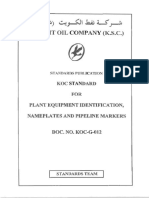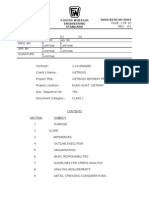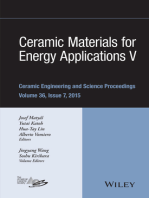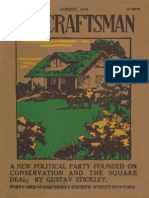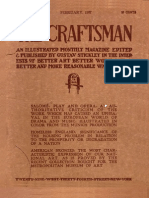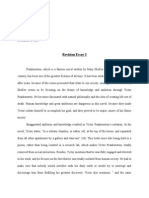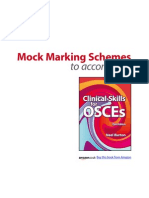Cathodic Protection Systems Interim Technical Guide
Cathodic Protection Systems Interim Technical Guide
Uploaded by
mdc2013Copyright:
Available Formats
Cathodic Protection Systems Interim Technical Guide
Cathodic Protection Systems Interim Technical Guide
Uploaded by
mdc2013Original Description:
Copyright
Available Formats
Share this document
Did you find this document useful?
Is this content inappropriate?
Copyright:
Available Formats
Cathodic Protection Systems Interim Technical Guide
Cathodic Protection Systems Interim Technical Guide
Uploaded by
mdc2013Copyright:
Available Formats
11012 04C/cmm
From: Commander, Naval Facilities Engineering Command (Code 15C) To: Distribution Subj: CATHODIC PROTECTION SYSTEMS, INTERIM TECHNICAL GUIDANCE Ref: (a) DPL-90-0006, Cathodic Protection Systems, Policy Guide (b) CFR Title 49 Chapter 1, Part 192, Transportation of Natural and Other Gas by Pipeline; and Part 195, Transportation of Liquids by Pipeline (c) CFR Title 40 Part 280, Technical Standards and Corrective Action for Owners and Operators of Underground Storage Tanks (d) MIL-HDBK-1004/10, Electrical Engineering, Cathodic Protection (e) NAVFAC MO-306, Maintenance and Operation of Cathodic Protection Systems (f) NAVFACINST 11014.52 Encl: (1) Interim Design Criteria for Cathodic Protection Systems (2) EFD Points of Contact for Corrosion Control, October 93 1. Purpose: To provide interim technical guidance for the use of cathodic protection systems (CPS) in shore utility systems and facilities. The guidance can be retained for record purposes until it is incorporated in the criteria noted in paragraph 4.d. This guidance supersedes and cancels reference (a). 2. Background: CPS reduce corrosion of buried or submerged metallic structures and utility systems, thus reducing the probability of failure with concomitant environmental, operational, safety and economic repercussions. Environmental laws prohibit the leakage of hazardous material into the environment. Additionally, the Navy spends millions of dollars annually repairing and replacing corroded metallic utility systems and structures that are unprotected by CPS. References (b) and (c) require the installation of CPS on certain buried or submerged steel gas, fuel and other hazardous material pipelines and storage facilities. However, in many cases CPS are not considered in the planning or design of such systems. Structures in corrosive environments also benefit from the installation of CPS, but are rarely considered for such protection. Some rehabilitation applications such as driving new sheet piling outboard of existing deteriorated piling, may result in the new sheet piling being anodic to the old and thus accelerating corrosion of the new sheet piling. Other similar rehabilitation projects may also incur a risk that repairs will accelerate corrosion. Finally, some NFGS guide specification sections currently do not adequately specify CPS requirements.
Subj: CATHODIC PROTECTION SYSTEMS, INTERIM TECHNICAL GUIDANCE 3. Technical Guidance: Provide corrosion protection measures on all new and existing buried or submerged metallic utility systems and metallic waterfront structures as described in enclosure (1). The overall corrosion protection system shall include cathodic protection systems, coatings, material thickness incrementation, encasement, or other methods as required by enclosure (1). Consult with the NAVFAC Criteria Office, Code 15C, or the cognizant EFD/EFA Corrosion Control Coordinator listed in enclosure (2) prior to deviating from this guidance. 4. Action: a. Planning. Include CPS requirements as a separate line item in cost estimates and planning documentation for the construction of new or the repair/upgrade of existing metallic utility systems and metallic structures described above. Include CPS narratives and cost estimates on DD Form 1391 under supporting utilities. Coordinate CPS requirements with the activity corrosion control plan to establish and ensure compatibility with existing systems. The cognizant EFD Corrosion Control Coordinator can assist in determining the system requirements. b. Design. Navy engineers and architects in charge of design (AIC/EIC): ensure that project designs include CPS where required and appropriate, and comply with reference (d), enclosure (1) and other applicable Military Handbooks and Design Manuals including specifications for CPS in NFGS-16641 or NFGS-16642 as applicable; refer to NFGS-16641 or NFGS-16642 as applicable in specifications that reference CPS (e.g., NFGS-02682 and NFGS-02694); in designs prepared for the Air Force, comply with the current Air Force CPS Engineering Technical Letter (ETL) and coordinate with the Air Force Base Corrosion Engineer. c. Construction. The Navy Officer in Charge of Construction and Resident Officer in Charge of Construction (OICC/ROICC): perform CPS construction inspections and ensure as-built drawings provide locations of all CPS equipment, test stations, insulating fittings, etc.; supervise the acceptance tests of the CPS to ensure the tests comply with procedures specified in the contract documents. In the absence of a qualified CPS inspector, obtain assistance from the EFD corrosion control coordinator, see enclosure (2). d. Criteria. The NAVFAC Criteria Office: coordinate the revision of the following criteria to incorporate the CPS interim technical guidance: MIL-HDBK-1025/1, Piers and Wharves MIL-HDBK-1025/2, Dockside Utilities for Ship Service MIL-HDBK-1025/6, General Criteria Waterfront Construction MIL-HDBK-1002/1, Structural Engineering, General Requirements MIL-HDBK-1002/3, Structural Engineering, Steel Structures
Subj: CATHODIC PROTECTION SYSTEMS, INTERIM TECHNICAL GUIDANCE
MIL-HDBK-1003/8A, Exterior Distribution of Utility Steam, High Temperature Water, Chilled Water, Natural Gas MIL-HDBK-1004/10, Cathodic Protection Design Manual 7.2, Foundations and Earth Structures Design Manual 22, Petroleum Fuel Facility NFGS-01730, Operation Maintenance Data NFGS-02368, Rolled Steel Section Piles NFGS-02366, Sheet Steel Piles NFGS-02666, Exterior Water Distribution NFGS-02661, Exterior Water Distribution Minor Construction NFGS-02682C, Exterior Fuel Distribution NFGS-02685, Gas Distribution System NFGS-02694, Exterior Underground Heat System NFGS-02697B, Exterior Buried Pumped Condensate Return NFGS-02698, Exterior Buried Preinsulated Water Piping NFGS-13209, Water Storage Tank NFGS-13216, Underground Petroleum Tanks NFGS-15486, Aviation Fuel Distribution and Dispenary NFGS-15488, LP Compressed Air System NFGS-15489, HP Compressed Air System NFGS-15492, Fuel Gas Piping NFGS-15511, Low Temperature Water NFGS-16641, Cathodic Protection NFGS-16643, Water Tanks e. Operation and Maintenance. Perform maintenance according to references (e) and (f), CPS Operation and Maintenance Support Information (OMSI) Manuals and cognizant EFD requirements. f. Training. The National Association of Corrosion Engineers (NACE), various academic institutions, and the various services offer CPS design and inspection courses. Contact the cognizant EFD Corrosion Control Coordinator for recommended training courses. 5. Points of Contact: For additional information concerning design criteria, please contact Mr. Charles Mandeville, P.E., Electrical Engineering Criteria Manager, NAVFACENGCOM Code 15C, at DSN 564-9599 or commercial (804) 444-9599. For additional information concerning maintenance criteria, please contact Mr. Bruce Bell, NAVFACENGCOM, Code 1334, at DSN 221-0046 or commercial (703) 325-0046. The technical point of contact for
Subj: CATHODIC PROTECTION SYSTEMS, INTERIM TECHNICAL GUIDANCE
CPS is Mr. Tom Tehada, PACNAVFACENGCOM, Code 1621A. He can be reached at DSN 312-5949 or commercial (808) 474-5360.
P. N. BOLTON By direction Distribution: CINCUSACOM CINCLANTFLT CINCPACFLT COMSUBLANT COMSUBPAC COMNAVSURFLANT COMNAVSURFPAC COMNAVAIRLANT COMNAVAIRPAC COMNAVAIRSYSCOM COMNAVSEASYSCOM COMNAVFACENGCOM (1334/Bruce Bell) NFESC NFESC (ESC52/J. Jenkins) NFESC (ESC63/R. Drisko, Melina Tye, Dan Polly) LANTNAVFACENGCOM LANTNAVFACENGCOM (1614E/Dave Jutton) LANTNAVFACENGCOM (404/Karl Liebrich) SOUTHNAVFACENGCOM SOUTHNAVFACENGCOM (1621RC/Ray Caniglia, 1621EP/Eddie Piedmont) NORTHNAVFACENGCOM NORTHNAVFACENGCOM (09TB/RS/Ron Shatz) SOUTHWESTNAVFACENGCOM SOUTHWESTNAVFACENGCOM (1631:SP/Sandy Pusey) PACNAVFACENGCOM PACNAVFACENGCOM (1621A/Tom Tehada, Joel Young) WESTNAVFACENGCOM WESTNAVFACENGCOM (T2B2JN/Jess Novero) ENGFLDACT CHESAPEAKE ENGFLDACT MW ENGFLDACT NW ENGFLDACT MED 4
Subj: CATHODIC PROTECTION SYSTEMS PWC GQ PWC GREAT LAKES PWC JACKSONVILLE PWC NORFOLK PWC PEARL HARBOR PWC PENSACOLA PWC SAN DIEGO PWC SAN FRANCISCO PWC WASHINGTON PWC YOKOSUKA ROICC CHERRY POINT ROICC JAXNCA ROICC NNSY ROICC NORFOLK ROICC OCEANA ROICC YORKTOWN ROICC ARGENTIA ROICC AZORES ROICC BERMUDA ROICC GTMO ROICC KEFLAVIK ROICC PRA ROICC PCA OIC/FSC NAVSECGRUACT NORTHWEST OIC/FSC NCTAMS LANT NORFOLK OIC/FSC DAM NECK OIC/FSC NSC CHEATHAM ANNEX OIC/FSC NAS OCEANA OIC/FSC ANTIGUA OIC/FSC GTMO OIC/FSC NAVSTA ROOSEVELT ROADS OICC NAVHOSP PORTSMOUTH OICC GQ OICC MIDPAC PEARL HARBOR OICC PACNAVFACENGCOM DET YOKOSUKA JA OICC TRIDENT KINGS BAY GA Copy to: COMNAVBASE SAN DIEGO COMNAVBASE SAN FRANCISCO COMNAVBASE PEARL HARBOR COMNAVBASE NORFOLK 5
Subj: CATHODIC PROTECTION SYSTEMS
COMNAVMARIANAS GQ COMNAVFORJAPAN YOKOSUKA JA CNET PENSACOLA 15G (Kersten) Blind copy to: 04CP 04C2(rdc) 04C(RF)/ssf c:/netdata/word/cm/mandeville/apr94/cpsguid.doc
INTERIM DESIGN CRITERIA FOR CATHODIC PROTECTION SYSTEMS April 1994 1. Provide Cathodic Protection Systems (CPS) and protective coatings for the following buried or submerged metallic utility systems regardless of soil or water corrosivity: a. b. c. d. e. f. Natural gas pipelines Petroleum, Oil and Lubricant (POL) pipelines Oxygen pipelines Underground POL and gasoline storage tanks Underground hazardous substance storage tanks All water storage tanks interiors
2. Consider CPS in conjunction with other protective measures such as material thickness incrementation, protective coatings and encasement for the following waterfront metallic structural systems: a. b. c. d. Steel sheet piling bulkheads Steel bearing piles for piers Steel fender piles for piers Mooring components
In marine environments, CPS are most effective and can greatly extend the life of the submerged zones of steel waterfront structures. The splash and atmospheric zones will require reapplication of coatings and encasements for maximum system service life. Partial concrete encasement of steel piles creates a zone of high potential at the concrete encasementto-bare steel pile interface where submerged. CPS should be provided in these circumstances in addition to the partial encasement. 3. Install CPS for the exterior bottoms of steel above ground POL storage tanks (AST) with or without impervious liners unless field tests and inspections by a qualified corrosion engineer indicate the environment to be non-corrosive. Existing tanks with bottoms on oil-filled sand pads on plastic liners are not necessary. However, when these tank bottoms are replaced, provide CPS unless field tests and inspections by a qualified corrosion engineer indicate the environment to be non-corrosive. 4. Provide CPS and bonded protective coatings on other buried or submerged new steel, ductile iron, or cast iron utility pipelines not mentioned above when the resistivity is below 30,000 ohms at the installation depth at any point along the installation. Do not use unbonded protective coatings such as loose polyethylene wraps. Provide joint bonding on all ductile iron and cast iron installations. Enclosure (1)
5. Economic feasibility of providing CPS shall be evaluated for the following buried or submerged systems: a. Gravity sewer lines, force mains b. Existing steel waterfront structures c. Reinforcing steel in concrete d. Cast/ductile iron potable water lines in soils with resistivities greater than 30,000 ohm-cm along its entire length e. Concentric neutral cable f. Below ground hydraulic elevator cylinders g. All buried or submerged metallic structures not mentioned above. Implementation of CPS on these systems shall be based on life-cycle economics. The requirements for CPS shall be determined by the corrosion engineer. 6. When rehabilitating existing steel sheet pile bulkheads by driving new sheets outboard of the existing, include the following requirements for the CPS: a. Electrically isolate new piling from old piling. b. Electrically isolate tie rods from existing sheet piling by cutting a hole in the old pile and providing a dielectric sleeve through the pile. c. Coat tie rods and new piling on all sides. d. Consider CPS as part of the total corrosion protection system. Use conventional soil side anodes to protect the seaside and landside of the pile and to protect the tie rods if field tests indicate this to be feasible. Otherwise, consider using a deep anode bed system. Waterside anodes are appropriate only in areas not subject to maintenance dredging, water turbulence from ship/boat traffic, normal or storm generated heavy wave action, or constant movement of the sea bottom. Conduct a site survey to determine the appropriate anode configuration and cathodic protection system requirements. 7. CPS shall provide protective potentials according to the requirements of the National Association of Corrosion Engineer (NACE) Standard RP01-69 (latest revision), Control of External Corrosion on Underground or Submerged Metallic Piping Systems and NACE Standard RPO2-85 (latest revision), Control of External Corrosion on Metallic Buried, Partially Buried, or Submerged Liquid Storage Systems. 8. Architect-Engineer (A-E) CPS surveys and designs shall be accomplished under the supervision of one of the following individuals: a. Registered Professional Corrosion Engineer b. Registered Professional Engineer who is also a NACE certified corrosion protection specialist or cathodic protection specialist or has a minimum of five years of experience in the applicable CPS
c. NACE certified corrosion protection specialist or cathodic protection specialist with a minimum of five years experience in the applicable CPS. CPS surveys or designs accomplished by Navy in-house design personnel need not comply with paragraphs 8.a through 8.c above, but shall be reviewed by the cognizant EFD Code 16 Corrosion Control (C2) Coordinator or PACNAVFACENGCOM Code 1621A. 9. Perform field tests (resistivity, pH, current requirements, etc.) at the proposed installation to evaluate, as a minimum, soil and/or water corrosivity. The tests shall be used to design the CPS and assumptions shall be supported by the field test data. 10. Design submittals shall include as a minimum the following: a. PEP - soil and/or water corrosivity data, current requirement test data (if applicable), and all design calculations. b. Final drawings - CPS one line diagrams, locations of all Cathodic Protection equipment (Anodes, rectifiers, test stations, etc.), interference test points, installation details, insulating fittings, and bond connections. c. Final specifications - acceptance testing procedures including static (native) potentials, initial and final system potentials, and interference tests. Project Managers shall contact the EFD Corrosion Control Coordinator regarding the CPS design at the pre-final project phase and, upon request, shall forward the design documents to the Coordinator for review. 11. CPS shall be compatible with existing systems. When plastic pipe is selected to replace or extend existing pipe, thermal weld an insulated No. 8 AWG copper wire to the existing steel pipe and run the full length of the plastic pipe for continuity and locator tracing purposes. 12. Design CPS for overall system maintainability.
EFD POINTS OF CONTACT FOR CORROSION CONTROL MAY 1994
PRIMARY/ALTERNATE
Mr. Bruce Bell Code 1334
TELEPHONE
(703) 325-0046 DSN 221-0046 FAX (703) 325-6904 (804) 444-9634 DSN 564-9634 FAX (804) 444-9892 (804) 322-4650 DSN 565-4650 FAX (804) 322-4615 (808) 471-5949/5360 (808) 474-5949/5360 FAX (808) 474-5407 (415) 244-3583 DSN 494-3583 FAX (415) 244-3511 (215) 595-0524 DSN 443-0524 FAX (215) 595-0535
ADDRESS
COMNAVFACENGCOM 200 Stovall Street Alexandria, VA 22332-2300 COMNAVFACENGCOM 1510 Gilbert Street Norfolk, VA 23511-2699 LANTNAVFACENGCOM 1510 Gilbert Street Norfolk, VA 23511-2699 PACNAVFACENGCOM Pearl Harbor, HI 96860-7300
EFD CODE
Mr. C. M. Mandeville Code 15CP
Mr. Dave Jutton Code 1614E
Mr. Tom Tehada/ Mr. Joel Young Code 1621A Mr. Jess Novero Code T2B2JN
WESTNAVFACENGCOM 900 Commodore Drive San Bruno, CA 94066-2402 NORTHNAVFACENGCOM 10 Industrial Highway Mail Stop #82 Lester, PA 19113-2090 SOUTHNAVFACENGCOM P. O. Box 190010 North Charleston, SC 29419-9010
Mr. Ron Shatz Code 09TB/RS
Mr. Ray Caniglia Code 1621RC Mr. Eddie Piedmont Code 1621EP Ms. Sandy Pusey Code 1631SP
(803) 743-0625/0623 DSN 563-0625/0623 FAX (803) 743-0563
(619) 532-2917 DSN 522-2917 FAX (619) 532-3979 (805) 982-4797 DSN 551-4979 FAX (805) 985-1197 (805) 982-4234/4657 DSN 551-4234/4657 FAX (805) 982-1418/1409 (805) 982-1058 DSN 551-1058 FAX (805) 982-1418/1409 (618) 256-3067 DSN 576-3067
SOUTHWESTNAVFACENGCOM 1220 Pacific Highway San Diego, CA 92132-5190 NFESC 560 Center Drive Port Hueneme, CA 93043-4322 NFESC 560 Center Drive Port Hueneme, CA 93043-4322 NFESC 560 Center Drive Port Hueneme, CA 93043-4322 HQ Military Airlift Command DCS/Engineering and Services HQ MAC/DEMU Scott AFB, IL 62225-5001
SW
Mr. J. F. Jenkins Code ESC52
Dr. R. W. Drisko Ms. Melina Tye Code ESC63 Mr. Dan Polly
Mr. Barry W. Kollme
Enclosure (2)
You might also like
- CP SYSTEM - DESIGN DOCUMENT (Rev.01)Document46 pagesCP SYSTEM - DESIGN DOCUMENT (Rev.01)suman ghosh100% (2)
- Specification For Cathodic Protection DesignDocument39 pagesSpecification For Cathodic Protection Designhezron7771% (7)
- Coastal Engineering Manual: Overview And Coastal HydrodynamicsFrom EverandCoastal Engineering Manual: Overview And Coastal HydrodynamicsNo ratings yet
- Debate WorksheetsDocument3 pagesDebate Worksheetsapi-367974926100% (2)
- Sabp L 002Document27 pagesSabp L 002yoonchankim0911100% (1)
- API Co2 ReportDocument63 pagesAPI Co2 Reportsimonlopez2012No ratings yet
- Cookery Grade 9Document205 pagesCookery Grade 9gleezel anne100% (2)
- Plumbing - Dod Mil-Hdbk 1003-1Document47 pagesPlumbing - Dod Mil-Hdbk 1003-1hascribdNo ratings yet
- CW9 Part 1Document9 pagesCW9 Part 1Steve CowanNo ratings yet
- EnquiryDocument24 pagesEnquirySarath PurushothamanNo ratings yet
- DNV Rp-f103-2010 - Cathodic Protection of Submarine Pipelines by Galvanic AnodesDocument16 pagesDNV Rp-f103-2010 - Cathodic Protection of Submarine Pipelines by Galvanic AnodeszaxaderNo ratings yet
- DNV RP-F103Document16 pagesDNV RP-F103David Miles100% (1)
- Cathodic Protection System Using Ceramic AnodesDocument132 pagesCathodic Protection System Using Ceramic Anodesadeoye_okunoyeNo ratings yet
- Vav SystemDocument18 pagesVav SystemmohdnazirNo ratings yet
- FEED or RPT 08 004 - Applicable Codes and Standard - Rev.ADocument36 pagesFEED or RPT 08 004 - Applicable Codes and Standard - Rev.AMinh DoNo ratings yet
- NSCP Update TIEZA May22,2013Document135 pagesNSCP Update TIEZA May22,2013JungNo ratings yet
- Koc G 012Document29 pagesKoc G 012skguptaNo ratings yet
- 3PS Eq 002 - 01Document32 pages3PS Eq 002 - 01Bikas SahaNo ratings yet
- Ufc 3 430 09Document106 pagesUfc 3 430 09carlcrowNo ratings yet
- SMiRT-23 Paper 107Document10 pagesSMiRT-23 Paper 107ahmedalshawiNo ratings yet
- Steam BoilerDocument134 pagesSteam Boilerchikukotwal0% (1)
- Ufc 4 832 01nDocument245 pagesUfc 4 832 01nsfadhilah_6No ratings yet
- Section 4: Specifications Specifications For Quick Release HookDocument17 pagesSection 4: Specifications Specifications For Quick Release HookAnonymous iM2totBrNo ratings yet
- Vol-II of IV - Laying - HPCLDocument753 pagesVol-II of IV - Laying - HPCLupesddn20100% (1)
- Electrical Engineering Cathodic ProtectionDocument319 pagesElectrical Engineering Cathodic ProtectionGiovanni LerasNo ratings yet
- Marine Painting HandbookDocument212 pagesMarine Painting HandbookVallabh Vishwanath Desai100% (4)
- Pipeline Field Joint CoatingDocument38 pagesPipeline Field Joint CoatingObinna Francis Mgbojikwe100% (2)
- p90264-11!99!91-0608 (Pipeline Mechanical Design Report)Document23 pagesp90264-11!99!91-0608 (Pipeline Mechanical Design Report)hasan.mohamed2305No ratings yet
- Plem Design and Analysis - OilfieldWikiDocument4 pagesPlem Design and Analysis - OilfieldWikilsatchithananthanNo ratings yet
- Electrial Power Distribution SystemsDocument69 pagesElectrial Power Distribution Systemskisan singhNo ratings yet
- Quick Guide For P&ID ReviewDocument7 pagesQuick Guide For P&ID ReviewfloredaNo ratings yet
- BSST-CP23163B Rev 0 Tech - CommentDocument8 pagesBSST-CP23163B Rev 0 Tech - CommentnisarbashaNo ratings yet
- Chlorination SystemDocument4 pagesChlorination Systemjkhan_724384No ratings yet
- 6.20 Offshore Mechanical Equipment Selection Philosophy PDFDocument13 pages6.20 Offshore Mechanical Equipment Selection Philosophy PDFDonald.KNo ratings yet
- Bd-Spc-Pap-Cc-1001 Specification For Protective Coating of Topsides Rev1Document48 pagesBd-Spc-Pap-Cc-1001 Specification For Protective Coating of Topsides Rev1benn savyasachiNo ratings yet
- Hydraulic Services Design 2019 05Document10 pagesHydraulic Services Design 2019 05Eugene BeangkeNo ratings yet
- Pipe Stress AnalysisDocument32 pagesPipe Stress Analysisjaky1383100% (4)
- PRG.E1-27.2020.07.10.Automatic Sprinkler SystemsDocument10 pagesPRG.E1-27.2020.07.10.Automatic Sprinkler Systemshassanqr89No ratings yet
- T1287e 3Document84 pagesT1287e 3Mahesh AnandNo ratings yet
- FPSO - Technical Specification For Marine TransportationDocument11 pagesFPSO - Technical Specification For Marine Transportationdndudc100% (1)
- 15 of 18 CTC Civil Engineering Design BasisDocument65 pages15 of 18 CTC Civil Engineering Design BasisRomoex R RockNo ratings yet
- Deepesh Merchant Jan 2013 - Apr 2013Document117 pagesDeepesh Merchant Jan 2013 - Apr 2013Rajesh Kumar Chaubey100% (1)
- Functional Specification For Deck CraneDocument31 pagesFunctional Specification For Deck Craneaiyubi20% (1)
- NRC Generic Letter 98-04Document21 pagesNRC Generic Letter 98-04jbasdNo ratings yet
- Setra Cable StaysDocument186 pagesSetra Cable StaysSoowhan Jung100% (7)
- 29.12.2021 Technical StandardsDocument4 pages29.12.2021 Technical StandardsgouthamaneeeNo ratings yet
- Technical Aspects Related to the Design and Construction of Engineered Containment Barriers for Environmental RemediationFrom EverandTechnical Aspects Related to the Design and Construction of Engineered Containment Barriers for Environmental RemediationNo ratings yet
- Summary Review on the Application of Computational Fluid Dynamics in Nuclear Power Plant DesignFrom EverandSummary Review on the Application of Computational Fluid Dynamics in Nuclear Power Plant DesignNo ratings yet
- Durability Design of Concrete Structures: Phenomena, Modeling, and PracticeFrom EverandDurability Design of Concrete Structures: Phenomena, Modeling, and PracticeNo ratings yet
- Applicability of IAEA Safety Standards to Non-Water Cooled Reactors and Small Modular ReactorsFrom EverandApplicability of IAEA Safety Standards to Non-Water Cooled Reactors and Small Modular ReactorsNo ratings yet
- Ceramic Materials for Energy Applications V: A Collection of Papers Presented at the 39th International Conference on Advanced Ceramics and CompositesFrom EverandCeramic Materials for Energy Applications V: A Collection of Papers Presented at the 39th International Conference on Advanced Ceramics and CompositesJosef MatyášNo ratings yet
- Application of the Principle of Defence in Depth in Nuclear Safety to Small Modular Reactors: Addendum to INSAG 10From EverandApplication of the Principle of Defence in Depth in Nuclear Safety to Small Modular Reactors: Addendum to INSAG 10No ratings yet
- Carbon Capture and Storage: The Legal Landscape of Climate Change Mitigation TechnologyFrom EverandCarbon Capture and Storage: The Legal Landscape of Climate Change Mitigation TechnologyNo ratings yet
- Design of Buildings for Wind: A Guide for ASCE 7-10 Standard Users and Designers of Special StructuresFrom EverandDesign of Buildings for Wind: A Guide for ASCE 7-10 Standard Users and Designers of Special StructuresRating: 3.5 out of 5 stars3.5/5 (2)
- How to prepare Welding Procedures for Oil & Gas PipelinesFrom EverandHow to prepare Welding Procedures for Oil & Gas PipelinesRating: 5 out of 5 stars5/5 (1)
- Quality and Reliability Aspects in Nuclear Power Reactor Fuel Engineering: Guidance and Best Practices to Improve Nuclear Fuel Reliability and Performance in Water Cooled ReactorsFrom EverandQuality and Reliability Aspects in Nuclear Power Reactor Fuel Engineering: Guidance and Best Practices to Improve Nuclear Fuel Reliability and Performance in Water Cooled ReactorsNo ratings yet
- The Craftsman - 1910 - 07 - JulyDocument143 pagesThe Craftsman - 1910 - 07 - Julymdc2013100% (3)
- The Craftsman - 1910 - 05 - MayDocument167 pagesThe Craftsman - 1910 - 05 - Maymdc2013100% (5)
- The Craftsman - 1910 - 02 - FebruaryDocument167 pagesThe Craftsman - 1910 - 02 - Februarymdc2013100% (3)
- The Craftsman - 1910 - 05 - MayDocument167 pagesThe Craftsman - 1910 - 05 - Maymdc2013100% (5)
- The Craftsman - 1910 - 08 - AugustDocument135 pagesThe Craftsman - 1910 - 08 - Augustmdc2013100% (3)
- The Craftsman - 1910 - 02 - FebruaryDocument167 pagesThe Craftsman - 1910 - 02 - Februarymdc2013100% (3)
- The Craftsman - 1910 - 08 - AugustDocument135 pagesThe Craftsman - 1910 - 08 - Augustmdc2013100% (3)
- The Craftsman - 1909 - 11 - November PDFDocument175 pagesThe Craftsman - 1909 - 11 - November PDFmdc2013100% (1)
- The Craftsman - 1910 - 01 - JanuaryDocument159 pagesThe Craftsman - 1910 - 01 - Januarymdc2013100% (4)
- The Craftsman - 1910 - 11 - NovemberDocument151 pagesThe Craftsman - 1910 - 11 - Novembermdc2013100% (4)
- The Craftsman - 1910 - 07 - JulyDocument143 pagesThe Craftsman - 1910 - 07 - Julymdc2013100% (3)
- The Craftsman - 1909 - 08 - August PDFDocument147 pagesThe Craftsman - 1909 - 08 - August PDFmdc2013No ratings yet
- The Craftsman - 1908 - 04 - April PDFDocument151 pagesThe Craftsman - 1908 - 04 - April PDFmdc2013No ratings yet
- The Craftsman - 1909 - 05 - May PDFDocument163 pagesThe Craftsman - 1909 - 05 - May PDFmdc2013No ratings yet
- The Craftsman - 1909 - 10 - October PDFDocument164 pagesThe Craftsman - 1909 - 10 - October PDFmdc2013100% (1)
- The Craftsman - 1909 - 09 - September PDFDocument99 pagesThe Craftsman - 1909 - 09 - September PDFmdc2013No ratings yet
- The Craftsman - 1908 - 10 - October PDFDocument171 pagesThe Craftsman - 1908 - 10 - October PDFmdc2013No ratings yet
- The Craftsman - 1909 - 01 - January PDFDocument163 pagesThe Craftsman - 1909 - 01 - January PDFmdc2013No ratings yet
- The Craftsman - 1909 - 04 - April PDFDocument173 pagesThe Craftsman - 1909 - 04 - April PDFmdc2013100% (1)
- The Craftsman - 1909 - 07 - July PDFDocument155 pagesThe Craftsman - 1909 - 07 - July PDFmdc2013No ratings yet
- The Craftsman - 1908 - 07 - July PDFDocument131 pagesThe Craftsman - 1908 - 07 - July PDFmdc2013No ratings yet
- The Craftsman - 1908 - 01 - January PDFDocument151 pagesThe Craftsman - 1908 - 01 - January PDFmdc2013No ratings yet
- The Craftsman - 1909 - 02 - February PDFDocument151 pagesThe Craftsman - 1909 - 02 - February PDFmdc2013No ratings yet
- The Craftsman - 1907 - 04 - April PDFDocument163 pagesThe Craftsman - 1907 - 04 - April PDFmdc2013No ratings yet
- The Craftsman - 1907 - 02 - February PDFDocument168 pagesThe Craftsman - 1907 - 02 - February PDFmdc2013No ratings yet
- The Craftsman - 1908 - 09 - September PDFDocument147 pagesThe Craftsman - 1908 - 09 - September PDFmdc2013No ratings yet
- The Craftsman - 1908 - 02 - February PDFDocument150 pagesThe Craftsman - 1908 - 02 - February PDFmdc2013100% (1)
- The Craftsman - 1908 - 11 - November PDFDocument169 pagesThe Craftsman - 1908 - 11 - November PDFmdc2013100% (1)
- The Craftsman - 1907 - 12 - December PDFDocument169 pagesThe Craftsman - 1907 - 12 - December PDFmdc2013100% (1)
- The Craftsman - 1907 - 03 - March PDFDocument180 pagesThe Craftsman - 1907 - 03 - March PDFmdc2013No ratings yet
- Microsoft Word - AppearanceMEnetDocument1 pageMicrosoft Word - AppearanceMEnetinmaNo ratings yet
- Tea ExtractDocument19 pagesTea Extractbharat mahajanNo ratings yet
- Ice Cream Pasteurizing Machine PASTOMASTER 60 RTXDocument42 pagesIce Cream Pasteurizing Machine PASTOMASTER 60 RTXKrissaline100% (1)
- Elements and Principles of DesignDocument2 pagesElements and Principles of Designzephyrvos4No ratings yet
- 10 Steps To Better Extract BrewingDocument3 pages10 Steps To Better Extract BrewingDomagoj ĆosićNo ratings yet
- Sinai 2Document408 pagesSinai 2nadirfiratNo ratings yet
- WW 16 - 20Document25 pagesWW 16 - 20tashinadeniseNo ratings yet
- Revision Essay 3Document3 pagesRevision Essay 3api-302254756No ratings yet
- BMW E90 Cablu Plus - Ramane Fara Curent Masina Rezolvare 1Document5 pagesBMW E90 Cablu Plus - Ramane Fara Curent Masina Rezolvare 1MariusŢanuNo ratings yet
- UPS & InvertersDocument56 pagesUPS & InvertersMustafa SobhyNo ratings yet
- Afp 20170615 P 805Document1 pageAfp 20170615 P 805Janaina MarquesNo ratings yet
- Working at Height PermitDocument1 pageWorking at Height PermitharikrishnaNo ratings yet
- DEKSTRIP Expandable Edged Flashing Product Data 661408Document2 pagesDEKSTRIP Expandable Edged Flashing Product Data 661408luisNo ratings yet
- Removable Partial Dentures - Principles of DesignDocument34 pagesRemovable Partial Dentures - Principles of DesignRalf GuscottNo ratings yet
- Xylitol TechnologyDocument19 pagesXylitol TechnologyDIPAK VINAYAK SHIRBHATE100% (4)
- Food Manual 10.12 FinalDocument62 pagesFood Manual 10.12 FinalNeon GNo ratings yet
- 10 Things in Nature Related in MathematicsDocument2 pages10 Things in Nature Related in MathematicsKatrina Kye MaghanoyNo ratings yet
- Cooney JARCE 37 2000Document34 pagesCooney JARCE 37 2000Angelo_ColonnaNo ratings yet
- Canon I-Sensys Mf8230cnDocument750 pagesCanon I-Sensys Mf8230cnhammoudeh13No ratings yet
- OSCES Mock Marking SchemeDocument126 pagesOSCES Mock Marking SchemeJennifer Motwani100% (1)
- MR 180 EditedDocument6 pagesMR 180 EditedfatmadianaNo ratings yet
- Important IdiomsDocument7 pagesImportant IdiomsIntzarEltlNo ratings yet
- Ans 2 (Core)Document20 pagesAns 2 (Core)suhaankochhar2008No ratings yet
- Greedy AlgorithmsDocument110 pagesGreedy AlgorithmsMITALBAHEN DHOLAKIYANo ratings yet
- 2222222222Document6 pages2222222222APEX SONNo ratings yet
- Environmental Economics An Introduction 7th Edition Field Test BankDocument8 pagesEnvironmental Economics An Introduction 7th Edition Field Test Bankherbistazarole5fuyh6100% (31)
- Wear Resistant Steel: Material Data Sheet, Edition April 2016Document6 pagesWear Resistant Steel: Material Data Sheet, Edition April 2016Zoltán PálfyNo ratings yet
- Group 2 - L2 - ManuscriptDocument5 pagesGroup 2 - L2 - ManuscriptAriff HaiqalNo ratings yet
















